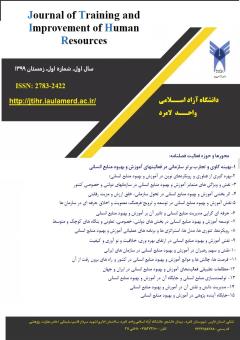شناسایی و تعیین متغیرهای زمینه ای در طراحی خط مشی های مدیریت تنوع فرهنگی در سازمان های دولتی ایران
الموضوعات : title1
علیرضا علی نژادجیدان
1
![]() ,
مهدی بابای اهری
2
,
جواد محرابی
3
,
مهدی بابای اهری
2
,
جواد محرابی
3
1 - دانشجوی دکتری، مدیریت دولتی، دانشکده مدیریت، حسابداری و علوم انسانی، دانشگاه آزاد اسلامی واحد قزوین، قزوین، ایران
2 - عضو هیئت علمی ، گروه مدیریت ، موسسه آموزش عالی ادیبان ، گرمسار، ایران
3 - گروه مدیریت دولتی، دانشکده مدیریت، حسابداری و علوم انسانی، دانشگاه آزاد اسلامی واحد قزوین، قزوین، ایران
الکلمات المفتاحية: مدیریت تنوع, تنوع فرهنگی, خط مشی, سازمان های دولتی, فراتحلیل.,
ملخص المقالة :
در دهههای اخیر مدیریت تنوع درمطالعات مدیریت و سازمان، به یک حوزه تحقیقاتی رو به رشد تبدیل شده است. علیرغم محبوبیت مدیریت تنوع، اثرات این شیوهها به جزنمایش عددی گروههای به حاشیه رانده شده دررتبههای مدیریتی مورد مطالعه قرار نگرفته است. لذا هدف از پژوهش حاضر، شناسایی و تعیین متغیرهای زمینه ای درطراحی خط مشیهای مدیریت تنوع فرهنگی درسازمانهای دولتی ایران می باشد. در این پژوهش، ابتدا دادههای کیفی از طریق مطالعات کتابخانه ای(فیش برداری) جمع آوری شده و براساس فراتحلیل مورد ارزیابی قرار گرفته اند. متغیرهای زمینه ای در طراحی خط مشیهای مدیریت تنوع فرهنگی در سازمانهای دولتی ایران 10شاخص بدست آمد که در مقوله مدیریتی و مقوله اجتماعی بحث گردید. درمقوله مدیریتی، توسعه و ادراکات فرهنگی و درمقوله اجتماعی، سازگاری فرهنگی بین ساختاری به عنوان مضامین مکرردر سراسر پژوهش موردبررسی ظاهر شد که نشان دهنده تأثیر قابل توجه آنها است. یافته ها نشان می دهد که نیاز به رویکرد جامع تری برای مدیریت تنوع در سازمان های دولتی ایران شاخص های شناسایی شده، مانند توسعه و ادراکات فرهنگی در مقوله مدیریت، و سازگاری فرهنگی بین ساختاری در مقوله اجتماعی، ماهیت چندوجهی مدیریت تنوع فرهنگی را برجسته می کند. این امر بر اهمیت درنظر گرفتن عوامل مدیریتی و اجتماعی درطراحی و اجرای سیاست هایی با هدف پرورش تنوع فرهنگی در این سازمان ها تاکید می کند. تحقیقات بیشتر و کاربردهای عملی در این زمینه میتواند به شیوههای مؤثرتر و فراگیرتر مدیریت تنوع منجر شود، که درنهایت به نفع سازمانها و افراد متنوعی است که آنها را در بر میگیرد.


